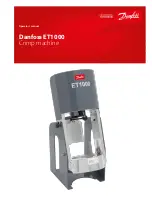
53
General Sharpening Procedures
On a belt sander, I prefer to hold the gouge nearly
horizontal as I hone (as shown in the bottom photo on
page 51). It is important that it be skewed slightly in the
direction of travel of the belt. I prefer using a reversible
motor on the belt sander, so that shaping can be done with
the belt running from top to bottom and honing done with
the belt running from bottom to top. It can all be done
with the belt running only one way (from top to bottom,
as shown in the photos on page 51), but it requires a few
more contortions.
On a felt wheel, I would again use the same general
grip, using a trailing cut on the side of the wheel or
the face of the wheel depending upon light conditions.
Generally, I use the side of the wheel for fi ne work
because it allows better angular control (see the top left
photo on the facing page). The face of the wheel is fi ne
for heavy polishing or, if shaped, for honing as well, but
you run a higher risk of dubbing an edge. Where shop
lighting is directly overhead, it is easier to use the face
of the wheel for everything (just another argument for
good lighting at your grinding station).
For honing the inside of the gouge (and whether or not
you put any bevel on the inside, you have to hone it to a
mirror fi nish if you want a good cutting edge), I prefer a
shaped felt wheel charged with chromium-oxide honing
compound (bottom left photo on the facing page). But a
very close second, and in some instances a fi rst choice,
is a piece of wood formed by the gouge itself for honing
both the inside and the outside.
It is simple to cut the edge of a scrap of wood to shape
for the inside of the gouge (top right photo on the facing
page) and to carve a groove in the face of the same
scrap for honing the outside bevel (bottom right photo
on the facing page). It is a highly effective sharpening
device that can be made at virtually no cost. Dressed
with chromium-oxide honing compound, the strop can
be kept at hand when you are carving so that you can
give a tool a quick touchup without having to leave your
carving station.
Bent Gouges
Bent gouges, which are used on recessed surfaces,
include curved gouges and spoon gouges. A curved
gouge is used where there is a reasonable amount
of maneuvering room, and a spoon gouge in very
restricted spaces. Bent gouges are subject to all of the
same considerations as straight gouges, although they
do present some special diffi culties when it comes to
truing the sweep and honing the inside.
You can use the same
general principles for
truing the sweep on
bent gouges as you do
with straight gouges,
but you must deal with
a much shorter section
of the tool because the
tool is bent. A coating
of liquid sandpaper or
PSA-backed abrasive
on a shopmade wooden
cone is the easiest way
to address the problem
(see the photo on the
right). This will true
only a short section of
the gouge, but it can also
be used for grinding the
inside bevel of the tool.
The best method, one
that will accommodate
the curve of the gouge,
is to shape a wooden
disk of appropriate
diameter to the correct
shape and apply liquid
sandpaper to it. Like the
cone this could be used
in a hand drill, clamped
in a vise or in a drill
press, either method
leaving both hands free
to manipulate the tool.
The same basic shape will do for honing bent gouges, but
in this case the wood should be charged with chromium-
oxide honing compound only.
To true the sweep using a drill-
press-mounted cone, hold the
gouge against the cone at a slight
skew so that the cone gives a
trailing stroke as it rotates.
Bent Gouges
Curved gouge
Spoon gouge
Back-bent gouge
Содержание Mk.II
Страница 6: ...vi Veritas Mk II Power Sharpening System ...
Страница 14: ...8 Veritas Mk II Power Sharpening System ...
Страница 20: ...14 Veritas Mk II Power Sharpening System ...
Страница 33: ...27 Exploded Assemblies Master Parts List 5 3 13 9 7 2 14 24 21 1 6 22 20 19 18 17 16 15 23 4 ...
Страница 36: ...30 Veritas Mk II Power Sharpening System ...
Страница 70: ...64 Veritas Mk II Power Sharpening System ...












































